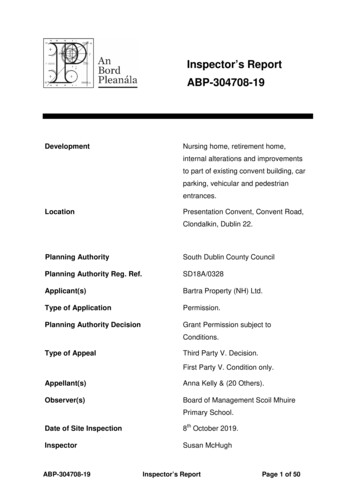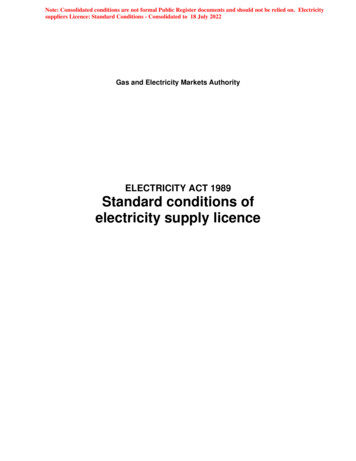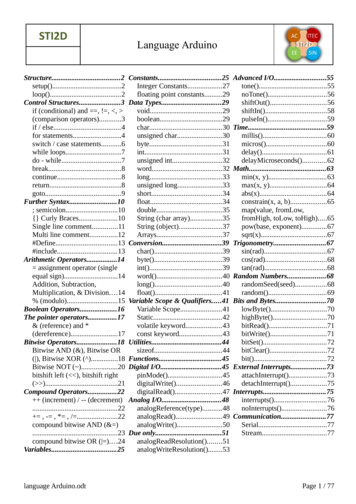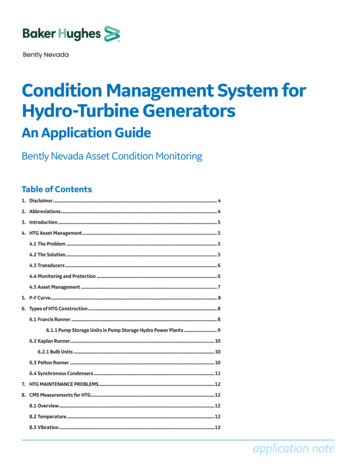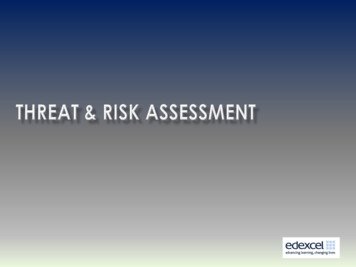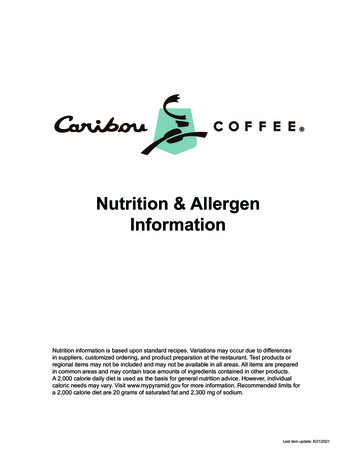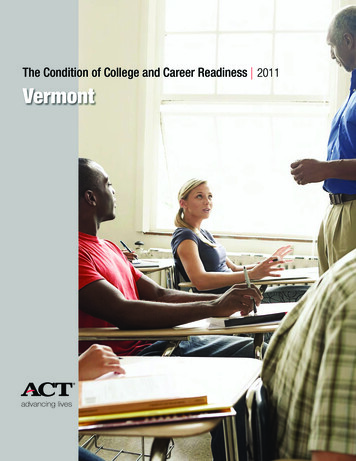
Transcription
The Condition of College and Career Readiness l 2011Vermont
ACT is an independent, not-for-profit organization that providesassessment, research, information, and program management servicesin the broad areas of education and workforce development. Eachyear we serve millions of people in high schools, colleges, professionalassociations, businesses, and government agencies, nationally andinternationally. Though designed to meet a wide array of needs, all ACTprograms and services have one guiding purpose—helping peopleachieve education and workplace success.A copy of this report can be found atwww.act.org/readiness/2011 2011 by ACT, Inc. All rights reserved. The ACT is a registered trademark of ACT, Inc., in the U.S.A. and other countries. ACTNational Curriculum Survey , EXPLORE , and PLAN are registered trademarks of ACT, Inc. College Readiness Standards andENGAGE are trademarks of ACT, Inc.
VermontThe Condition of College and Career Readiness Class of 2011invaluable resource as ACT works closely with states andschool districts to transform the nation’s P–16 educationsystem.Annually, ACT provides a snapshot of the college andcareer readiness of ACT-tested high school graduates. Weoffer this report as a service to inform policymakers andpractitioners about selected indicators of effectivenessand how that translates into readiness. It is designed tostimulate discussion, inquiry, and action. In interpretingand using the results, keep in mind that the number andpercentage of 2011 graduates who took the ACT in yourstate determine how representative these findings are.College and Career Readiness DefinedACT has long defined college and career readiness as theacquisition of the knowledge and skills a student needs toenroll and succeed in credit-bearing first-year courses at apostsecondary institution (such as a two- or four-yearcollege, trade school, or technical school) without theneed for remediation. ACT’s definition of college andcareer readiness was adopted by the Common CoreState Standards Initiative, which serves as validation ofour extensive research and ACT’s College and CareerReadiness Standards. Our Unique Added ValueACT has been measuring the academic achievement of11th- and 12th-grade students since 1959, their careeraspirations since 1969, and their academic preparation inhigh school since 1985. ACT’s data system includes eachof these areas for 8th and 10th graders and has beenmonitoring student readiness and success for nearly twodecades. Since 1996, and every three to five yearsthereafter, ACT surveys thousands of high school andcollege educators to pinpoint the knowledge and skillsneeded for first-year college coursework. ACT is the onlyorganization with decades of empirical data showingexactly what happens to high school graduates once theyget to college or to work and how they can maximizesuccess—based on their preparation from kindergartenthrough high school. These unique data sets are anUsing This Report1This report is designed to help inform the followingquestions that are driving national efforts to strengthenP–16 education. Are your students prepared for college and career? Are enough of your students taking core courses? Are your core courses rigorous enough? Are your younger students on target for collegeand career? What other dimensions of college and career readinessshould we track?ACT’s College Readiness BenchmarksBenchmarks are scores on the ACT subject area teststhat represent the level of achievement required forstudents to have a 50% chance of obtaining a B orhigher or about a 75% chance of obtaining a C orhigher in corresponding credit-bearing first-year collegecourses. These college courses include EnglishCollege CourseSubject Area TestComposition, College Algebra, Biology, and anintroductory social science course. Based on anationally representative sample, the Benchmarks aremedian course placement values for these institutionsand as such represent a typical set of expectations.The ACT College Readiness Benchmarks are:EXPLORE BenchmarkPLAN BenchmarkACT BenchmarkEnglish CompositionEnglish131518Social SciencesReading151721College AlgebraMathematics171922BiologyScience2021243
College and Career Readiness inVermont 2,053 of your graduates,which is an estimated 28%of your graduating class,took the ACT.*Percent of 2011 ACT-Tested High School Graduates MeetingCollege Readiness Benchmarks by Subject100!80!78!66!Percent!Attainmentof Collegeand CareerReadiness From 2007–2011, thenumber of ACT test-takinggraduates has increased by10.7%, while the number ofgraduates in your state hasdecreased by eading!Mathematics!Vermont!Science!All Four!Subjects!Nation!Percent of 2007–2011 ACT-Tested High School GraduatesMeeting ACT College Readiness 008!Percent!80!* Totals for graduating seniors wereobtained from Knocking at theCollege Door: Projections ofHigh School Graduates by Stateand Race/Ethnicity, 1992 to 2022,7th edition. March 2008 bythe Western Interstate Commissionfor Higher Education.Note: Percents in this report may notsum to 100% due to ics!Science!2011!All Four Subjects!
College and Career Readiness inVermontPercent of 2011 ACT-Tested High School Graduates byBenchmark Attainment and entof Collegeand h!Reading!Mathematics!Science!Met Benchmark! Within 2 Points of Benchmark! Below Benchmark by 3 Points!Percent of 2011 ACT-Tested High School Graduates byNumber of ACT College Readiness Benchmarks AttainedMet NoBenchmarks!16%!Met All 4Benchmarks!33%!Met 1Benchmark!13%!Met 2Benchmarks!20%!Met 3Benchmarks!17%!5
College and Career Readiness inVermontOver the past decade,ACT has experiencedunprecedented growth in thenumber of students tested, aswell as statewide partnershipsin ten different states and inmany districts across thecountry. As a result, the 2011Condition of College andCareer Readiness reportprovides a much deeper andmore representative sample incomparison to a purelyself-selected college-goingpopulation.Percent of 2007–2011 ACT-Tested High School Graduatesby nand !Indian!Asian!1!2!1!2009!Hispanic!Pacific !Islander!2!2!2010!White!Two or!More Races!1!2!3!2011!No Response!Note: Less than 0.5% will not appear.Percent of 2007–2011 ACT-Tested High School GraduatesMeeting Three or More Benchmarks by 8!34!17!8!* Race/ethnicity categories havebeen changed to reflect updatedUS Department of Educationreporting requirements.260!0!2007!African ic!2010!Pacific!Islander!2011!White!
College and Career Readiness inVermontParticipation and Opportunity by SubjectPercent of 2011 ACT-Tested High School Graduates Meeting CollegeReadiness Benchmarks by Race/Ethnicity and 41!39!7
College and Career Readiness inVermontWithin subjects, ACT hasconsistently found thatstudents who take therecommended corecurriculum are more likely tobe ready for college or careerthan those who do not. A corecurriculum is defined as fouryears of English and threeyears each of mathematics,social studies, and science.3Percent of 2011 ACT-Tested High School Graduates inCore or More vs. Less Than Core Courses Meeting CollegeReadiness Benchmarks by Subject100!80!79!65!Percent!Course-TakingPatterns ish!Reading!Core or More!862!Mathematics!Less Than Core!7!Science!
College and Career Readiness inVermontEarly PreparationACT research shows that younger students who take arigorous curricula are more prepared to graduate fromhigh school ready for college or career. Moreover, ourrecent research (The Forgotten Middle, 2008) found that“the level of academic achievement that students attain by8th grade has a larger impact on their college and careerreadiness by the time they graduate high school thananything that happens academically in high school.”Percent of 2010–2011 PLAN-Tested 10th Graders Meeting College Readiness Benchmarks (N 2,445)100!13!27!80!11!40!49!Percent!14!Met NoBenchmarks!20%!Met eading!Mathematics!Met 2Benchmarks!22%!Met All 4Benchmarks!23%!30!Science!Met 3Benchmarks!16%!Met Benchmark! Within 2 Points of Benchmark! Below Benchmark by 3 Points!Percent of 2010–2011 EXPLORE-Tested 8th Graders Meeting College Readiness Benchmarks (N 157)# ofBenchmarksMetPercent!Insufficient data available0!English!Reading!Mathematics!Science!Met Benchmark! Within 2 Points of Benchmark! Below Benchmark by 3 Points!9
College and Career Readiness inVermontOther College and Career Readiness FactorsACT has found several othersubstantial factors that impactcollege and career readinessfor students. They includecareer and educationalplanning and the academicbehaviors of students.Percent of 2011 ACT-Tested High School Graduates withCareer Interests in Jobs Calling for a Two-Year Degree orMore in the State’s Five Fastest-Growing Career Fields425!Job Openings!Career !0!Many students who areinterested in these careerareas fall short of meetingACT’s College ReadinessBenchmarks, suggesting thatthey are not on the right pathto take advantage of careeropportunities in these highgrowth fields.Community! Management! ng/!Sales!Percent of 2011 ACT-Tested High School GraduatesInterested in High-Growth Careers Meeting CollegeReadiness Benchmarks by Subject100!80!78!78!77!62!Percent!Preparationfor Careers 54! ity! Management! !10Reading!Mathematics!Science!Marketing/!Sales!
College and Career Readiness inVermontOther College and Career Readiness FactorsPercent of 2011 ACT-Tested High School Graduates byEducational Aspirations100!Percent!80!Most students aspire to apost-high school credential.To help them meet thoseaspirations, educationalplanning, monitoring, andinterventions must be alignedto their aspirations, beginearly, and continue throughouttheir educational ch Degree!Aligning StudentBehaviors,Planning, andAspirationsOther/No!Response!Academic Achievement and Academic BehaviorsAverage High School GPA by EXPLORE Benchmarksand Academic Behavior ScalesAverage High School 4!2.0!1.6!1.5!1.0!0.5!0.0!0 Benchmarks!1 or 2 Benchmarks!Bottom 25%!Middle 50%!3 or 4 Benchmarks!Top 25%!Average Percentile Rank of Academic Behavior Scales!Impact of Academic Behaviorson High School PerformanceACT research based on alarge sample shows thatthe combination of academicachievement (as measured withEXPLORE) and academicbehaviors (as measured withENGAGE ) provide the strongestprediction of high schoolacademic performance andsuccess. This chart highlights theneed to address students’academic behaviors to improveperformance across allachievement levels.511
College and Career Readiness inVermont2011 StatePercent ofHigh SchoolGraduatesTested, AverageCompositeScore, andPercentMeetingBenchmarksby Subject12StatePercentAverageof Graduates re1622.474605739District of 6022.175635335Nebraska7622.176605036
College and Career Readiness inVermontStatePercentAverageof Graduates 68554730New Hampshire1823.785716643New Jersey1923.281676641New Mexico7219.855443221New York2823.480676845North Carolina1821.970585634North 625837Rhode Island1223.081685938South Carolina5620.159453923South st ng10020.361493624National4921.1665245302011 StatePercent ofHigh SchoolGraduatesTested, AverageCompositeScore, andPercentMeetingBenchmarksby Subject* Totals for graduating seniors were obtained from Knocking at the College Door: Projections ofHigh School Graduates by State and Race/Ethnicity, 1992 to 2022, 7th edition. March 2008 bythe Western Interstate Commission for Higher Education.13
College and Career ReadinessResourcesStates that incorporateACT’s college and careerreadiness solutions as partof their statewideassessments provide greateraccess to higher educationand increase the likelihood ofstudent success inpostsecondary education.Educators also have theability to establish alongitudinal plan using ACT’sassessments, which providehigh schools, districts, andstates with unique studentlevel data that can be usedfor effective studentintervention plans.Statewide Partnerships in College andCareer ReadinessState administration of ACT’sprograms and services: Increases opportunitiesfor minority and middleto low-income students.8th- and9th-gradestudents10th-grade 11th- and8th- thru11th- andNationalWorkKeys students12th-grade 12th-grade 12th-grade CareerbasedstudentsstudentsstudentsReadiness onnecticutArkansasIllinoisIllinoisIllinoisNorth Dakota yFlorida Correlates with increasesin college enrollment,persistence, and GeorgiaMinnesotaMinnesotaNorth ssissippi Aligns with statestandards.TennesseeTennesseeUtahNew Mexico North CarolinaTexasTexasWyomingNorth Dakota OklahomaUtahUtah Promotes studenteducational and careerplanning. Reduces the need forremediation.West Virginia West taWyomingPennsylvania VirginiaWest VirginiaSouthTennesseeUtahVermont14Wisconsin
College and Career ReadinessPolicies & PracticesHow to Increase College ReadinessNationally, approximately 28% of all 2011 ACT-tested highschool graduates did not meet any of the College ReadinessBenchmarks, meaning they were not prepared academicallyfor first-year college courses in English Composition, CollegeAlgebra, Biology, and social sciences. States and schools canimplement six policies and practices that can systemicallyincrease the percentage of their students who are ready forcollege-level work.Rigorous High School Courses. Having appropriateand aligned standards, coupled with a core curriculum, willadequately prepare high school students only if the coursesare truly challenging. That is, taking the right kinds of coursesmatters more than taking the right number of courses.Students who take a rigorous core curriculum should beready for credit-bearing first-year college courses withoutremediation.Essential Standards. Since ACT first released Making theDream a Reality in 2008, we have called for states to adoptessential standards that prepare all students for the rigors ofcollege or career training programs. With the adoption of theCommon Core State Standards by 45 states and the Districtof Columbia, most states have taken that first step on the roadto ensuring all students are ready for college or career. It isimperative now that policymakers and practitioners continuethis process by aligning all aspects of their systems to collegeand career readiness.Early Monitoring and Intervention. We know from ourempirical data that students who take challenging curricula aremuch better prepared to graduate high school ready forcollege or career training opportunities. If students are to beready for college or career when they graduate, their progressmust be monitored closely so that deficiencies in foundationalskills can be identified and remediated early, in upperelementary and middle school. In addition, age-appropriatecareer assessment, exploration, and planning activities thatencourage students to consider and focus on personallyrelevant career options should be a part of this process sothat students can plan their high school courseworkaccordingly.Common Expectations. All states—especially those thathave adopted the Common Core State Standards—should bealigning college and career readiness standards to a rigorouscore curriculum for all high school students whether they arebound for college or work. The levels of expectation forcollege readiness and workforce training readiness should becomparable. To ensure students master the knowledge andskills to succeed after high school, ACT supports the corecurriculum recommendations of A Nation at Risk: TheImperative for Educational Reform, specifically, that studentstake a core curriculum consisting of at least four years ofEnglish and three years each of mathematics, science, andsocial studies.Clear Performance Standards. States must define “howgood is good enough” for college and career readiness. Inaddition to a consistent, rigorous set of essential K–12 contentstandards, states must define performance standards so thatstudents, parents, and teachers know how well students mustperform academically to have a reasonable chance of successat college or on the job. Based on decades of studentperformance data, ACT defines “college readiness” asstudents having a 50% chance of earning a grade of B orhigher or about a 75% chance of earning a grade of C orhigher in first-year college English Composition; CollegeAlgebra; Biology; or History, Psychology, Sociology, PoliticalScience, or Economics.Data-Driven Decisions. States have been hard at work indeveloping longitudinal P–16 data systems—this work mustcontinue and accelerate. If states are serious about ensuringmore of their students are prepared for college and work in the21st century, they must develop systems that allow schoolsand districts to closely monitor student performance at everystage of the learning pipeline, from preschool through theelementary, middle, and high school grades, all the waythrough college. Use of a longitudinal data system enableseducators to identify students who are in need of academicinterventions at an early stage, thus giving teachers andstudents more time to strengthen these skills beforegraduation. Longitudinal data systems provide a tool toschools to ensure all their students take and complete theright number and kinds of courses before graduation. Using alongitudinal assessment system also permits schools toevaluate the value added by each core course in helpingstudents to become ready for college and career. Suchsystems also allow colleges to offer feedback reports to highschools that examine how well prepared each high school’sgraduates are for college. These reports can be used tostrengthen high school curricula.15
College and Career ReadinessResourcesACT ResearchThe Condition of College and Career Readiness l 2011As a not-for-profit educational research organization, ACT is committed toproducing research that focuses on key issues in education and workforcedevelopment. Our goal is to serve as a data resource. We strive to providepolicymakers with the information they need to inform education andworkforce development policy and to give educators the tools they need tolead more students toward college and career success. What follows aresome of ACT’s recent and most groundbreaking research studies. To reviewthese studies, go to www.act.org/research/summary.The Condition of College and Career ReadinessUsing ACT test scores and the ACT College Readiness Benchmarks, TheCondition of College and Career Readiness 2011 provides a series ofgraphics highlighting the college and career readiness of the ACT-tested highschool class of 2011. This report is updated annually.A First Look at the Common CoreForty-five states have adopted the Common Core State Standards. Now,efforts to implement the standards take on primary importance. ACT providesthis first look at student performance relative to the Common Core StateStandards and college and career readiness.Mind the GapsIn the research report Mind the Gaps: How College Readiness NarrowsAchievement Gaps in College Success, ACT looks at steps that can be takento improve college and career readiness and success among underservedpopulations. As a nation, we must close the achievement gap across racial/ethnic and family income groups. The report shows the types of policies thatwork to improve college and career readiness and success.Affirming the GoalIn our most recent research report, Affirming the Goal: Is College and CareerReadiness an Internationally Competitive Standard?, we examine howperformance standards in reading and math on PLAN compare toperformance on the Programme for International Student Assessment (PISA),a worldwide assessment of 15-year-old students’ academic achievement.16
College and Career ReadinessResourcesRigor at RiskAmong the motivations behind the federal government’s publication of ANation at Risk in 1983 were the desire to see more students graduate fromhigh school prepared for college and work and the need for more studentsto attend and graduate from college. A Nation at Risk proposed that everyUS high school require graduates to take a “core” curriculum—a minimumnumber of courses that would provide students with a “foundation of successfor the after-school years.” Nearly a quarter-century later, in a climate inwhich US workers are dealing with new forms of technology and facing thechallenges of a global economy, it is not only reasonable but increasinglyurgent to ask: Have we succeeded in fulfilling the goals of A Nation at Risk?On Course for SuccessIn On Course for Success, ACT and The Education Trust examine ten highschools with challenging student populations that have overcome the oddsby fostering greater access to college. We found that when students areprovided with high-level courses, qualified and experienced teachers,teaching that is flexible and responsive to students, and extra support whenthey need it, all students can be prepared to succeed.ACT National Curriculum Survey Obtained every three to four years from middle, secondary, andpostsecondary educators, this study collects data about what enteringcollege students should know and be able to do to be ready for college-levelcoursework in English, math, reading, and science. The survey results informongoing efforts to develop, refine, and update common academic standardssuch as the Common Core State Standards, as well as to informpolicymakers and educators. Results are also used to guide development ofACT’s curriculum-based assessments to ensure they meet the needs ofcollege and career readiness.Breaking New GroundBreaking New Ground: Building a National Workforce Skills CredentialingSystem introduces the need and associated benefits for establishing anational workforce credentialing system. The report outlines the importanceof bringing together a critical mass of state, national, and public and privateworkforce leaders to co-construct this foundational framework to address ournational workforce challenges.17
College and Career Readiness inVermontEndnotes1. The data presented herein are based on the ACT Profile Report—State:Graduating Class 2011 for each respective state, and accessible atwww.act.org/readiness/2011. With the exception of the top graph onpage 6, data related to students who did not provide information or whoresponded “Other” to questions about gender, race/ethnicity, high schoolcurriculum, etc., are not presented explicitly.2. The race/ethnicity categories have been changed from previous editions tonow reflect updated US Department of Education reporting requirements;trends to previous reports may not be available for all race/ethnicitycategories.3. Data reflects content-specific curriculum. For example, English “Core orMore” results pertain to students who took more than four years of English,regardless of courses taken in other content areas.4. State long-term occupational projections for 2008–2018 (based on jobgrowth and job replacement provided by Vermont Department of Labor).The occupations that are used to calculate the projected high-growthcareer fields are based on a combination of the following: the occupationalcriteria used by the US Bureau of Labor Statistics to obtain state-leveloccupation data, occupational shifts that reflect a state’s economicsituation, and the ACT Career Classification System that organizesoccupations into career fields. Career interests and achievement resultsbased on 2011 ACT-tested Vermont students (n 1,245) with valid careerinformation and subject scores. Sample occupations within state highgrowth career fields are Education (secondary teachers, administrators,etc.); Community Services (social workers, school counselors, etc.);Management (convention planners, hotel/restaurant managers, etc.);Computer/Information Specialties (computer programmers, databaseadministrators, etc.); Marketing/Sales (insurance agents, buyers, etc.).185. As 7th or 8th graders, 3,289 students were tested with EXPLORE, aswell as with an assessment of academic behaviors. The students camefrom 22 middle schools across eight states; the data reported in the graphare not specific to any particular state. The students were followed overtime and most completed high school in 2011. The chart presents themean high school GPA for nine groups of students. Each student’s groupis determined by the number of EXPLORE Benchmarks met (0, 1 or 2,3 or 4) and by the average percentile rank of ten academic behavior scalesmeasuring motivation, self-regulation, and social engagement. ACT’sENGAGE Grades 6–9 assessment was used to measure academicbehaviors. Performance in high school courses was higher for studentswith more EXPLORE Benchmarks met, and also higher for students withgreater motivation, self-regulation, and social engagement. Thecombination of pre-high school academic achievement and academicbehaviors provided the strongest prediction of high school academicperformance. These data highlight the need to address students’academic behaviors to improve their future academic performance.
College and Career Readiness inVermontACT National OfficeLansing Office500 ACT DriveP.O. Box 168Iowa City, Iowa 52243-0168Telephone: 319/337-10001001 Centennial WaySuite 400Lansing, Michigan 48917-8249Telephone: 517/327-5919West RegionColumbus OfficeSacramento Office2880 Sunrise BoulevardSuite 214Rancho Cordova, California95742-6103Telephone: 916/631-9200Mountain/PlainsRegionDenver Office3131 South Vaughn WaySuite 218Aurora, Colorado 80014-3507Telephone: 303/337-3273Southwest RegionAustin Office8701 N. MoPac ExpresswaySuite 200Austin, Texas 78759-8364Telephone: 512/320-1850Midwest RegionChicago Office300 Knightsbridge ParkwaySuite 300Lincolnshire, Illinois 60069-9498Telephone: 847/634-2560700 Taylor RoadSuite 210Gahanna, Ohio 43230-3318Telephone: 614/470-9828Northeast RegionBoston Office144 Turnpike RoadSuite 370Southborough, Massachusetts01772-2121Telephone: 508/229-0111Southeast RegionAtlanta Office3355 Lenox Road NESuite 320Atlanta, Georgia 30326-1332Telephone: 404/231-1952Tallahassee Office1315 East Lafayette StreetSuite ATallahassee, Florida 32301-4757Telephone: 850/878-2729NCEAAustin Office8701 N. MoPac ExpresswaySuite 200Austin, Texas 78759-8364Telephone: 512/320-1800ACT Nationaland RegionalOffices
A copy of this report can be found atwww.act.org/readiness/201116669
American! American! Indian! Asian! Hispanic! Pacific ! Islander! White! Two or! More Races! . College and Career Readiness in 8 Vermont Percent of 2011 ACT-Tested High School Graduates in Core or More vs. Less Than Core Courses Meeting College Readiness Benchmarks by Subject 79! 65! 62! 41! 51! 58! 11! 7! 0! 20! 40! 60! 80! 100! English .



